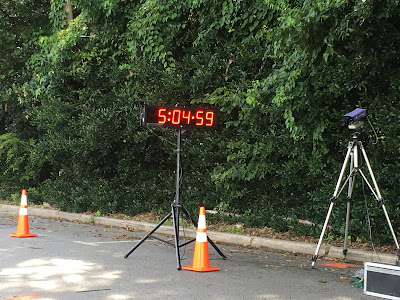A couple of weeks ago, the Atlanta Track Club sent an announcement about their first in-person running event since the marathon on March 1. This race was a 400 meter road race on Armour Drive in front of the Atlanta Track Club office, implementing safety measures such as racing by appointment, limited to 4 at a time. After dithering a day or two, I signed up (there were only about 150 spots available). I was hoping for an early morning appointment, but turns out that all of the running was between 4 pm - 7 pm, in the heat of the afternoon, so I signed up for a 5:00 pm appointment.
I arrived and parked on Ottley Drive around 4:40 pm, parallel to Armour Drive (which was blocked with cones). After applying a little sunscreen, I warmed up with about 3/4 of a mile. I didn't want to wear the good mask that I use for work, so I wore a makeshift face covering created from an old Publix Marathon cooling towel and a couple of Bonnie's hair bands, following a demo that I saw Sanjay Gupta present on CNN in the early weeks of the pandemic shutdown.
 |
| Dr. Sanjay Gupta at his home (above) Dr. Frank McDonald at his home (below) |
It was difficult to run with a face covering. I was conscious of sucking in the layers of fabric with each inhalation, and was glad that I wouldn't have to wear the face covering while running the race. It was great to see other runners from a distance, although I had trouble recognizing some through the masks.
I had mis-remembered my race start appointment! I thought that it was shortly after 5 pm, but turns out that my appointment was at 5:00 on the dot. By the time I had picked up my number, at the Atlanta Track Club office 300 meters from the starting line, it was 4:57 pm! I quickly jogged down the road and arrived at the starting line a few seconds before 4:59 pm. I hardly had a chance to cool down, but maybe that was a good thing. I was delighted to see that Bob Wells was running in the same heat! Bob is a tireless fan of runners and running in general. We're in the same age group, perhaps one year apart, and with similar abilities, although Bob is coming back from an injury.
30 seconds to go: I stepped up to the orange line painted on the road, reviewed in my mind the race strategy in 100 meter increments - PUSH - PACE - POWER - PRAY!
10 seconds to go, then 5 seconds to go, and oops! I'm still wearing my face covering! I whipped off the face covering and stuffed it in my running belt, just in time. 5:00:00 and the air horn sounded, and we were off!
PUSH: The man to my right took off like lightning out of a bottle. He quickly pushed away, out of sight and out of my mind. Bob and I were running at a similar pace, Bob immediately to my left. A woman was running directly behind me. I felt good, not running too hard, but off to a decent start, I thought.
PACE: After what I thought was about 100 meters, I settled into what felt like a pretty easy, automatic "float" pace. Bob pulled ahead of me by a few meters, running very well. We approached the man who typically handles the starting pistol at track meets, I don't know his name, but I had established on my way to the start that he was sitting at the 200 meter mark.
POWER: Time to re-invest in the race: I picked up the pace just a bit, began pumping my arms, and caught up to and passed Bob. Running strong, I could begin to see the finish line clock in the distance. Time for the last phase -
PRAY! I tried to kick into high gear but didn't seem to speed up. Passing the track club office, a woman shouts "125 meters to go!"
Error, error, error: I had begun to PRAY too soon.
There's a first time for everything, I thought.
My energy was fading. I could hear Bob's footsteps just behind me and to my left, but I was really tiring. I thought of the video of the coach describing runners vomiting after finishing the 400 meter race: fortunately my stomach was not upset, but I really had to push myself to get through the finish line.
To my surprise, I glimpsed 1:25 as I hit the orange line marking the finish. Whew, that was tough! I probably could have run that just a little better, especially if I had arrived at the start line more than 60 seconds before the race began.
Edit June 29: official time 1:25:84, 3rd out of 8 in my age group!
Edit June 29: official time 1:25:84, 3rd out of 8 in my age group!
 |
| The finish line clock right before the beginning of the next heat. |
Bob congratulated me on my race - thanks Bob! I could hardly breathe, as I had given so much effort. But after a couple of minutes, my breathing slowed, and I could put the face covering back on.
 |
| Looking back down the race course. Although it was a warm afternoon, 88 deg F, the entire route was nicely shaded. |
Coming up: a solo 10K on or around Independence Day in lieu of the Peachtree Road Race.
Then: three official Atlanta Track Club socially distanced races on three consecutive Saturdays, the "Publix Summer Series". I've registered for the 7:33 am start times for:
July 18: 1 mile
July 25: 5K
August 1: 8K
I wasn't sure what to expect with this format, but it was nice to race against others and to do so while maintaining safe distance. I'm looking forward to the Publix Summer Series!
























